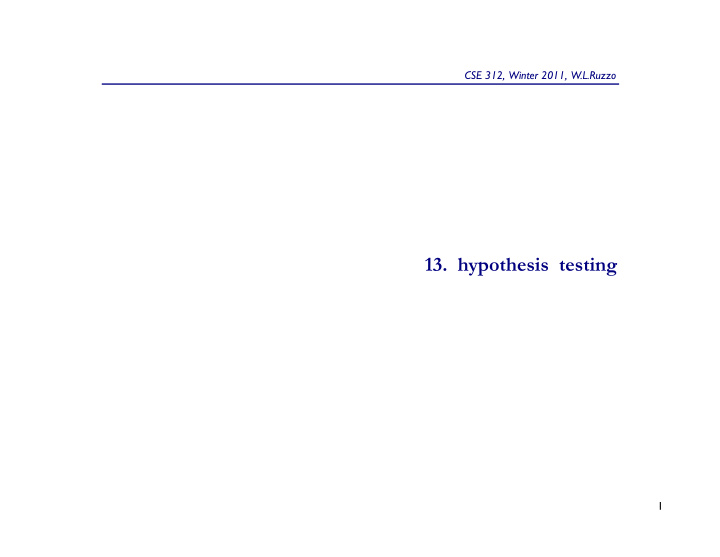



CSE 312, Winter 2011, W.L.Ruzzo 13. hypothesis testing 1
competing hypotheses 2
competing hypotheses 3
competing hypotheses 4
competing hypotheses 5
hypothesis testing E.g.: By convention, the null hypothesis is usually the “simpler” hypothesis, or “prevailing wisdom.” E.g., Occam’s Razor says you should prefer that unless there is good evidence to the contrary. 6
decision rules 7
error types 8
likelihood ratio tests 9
simple vs composite hypotheses note that LRT is problematic for composite hypotheses; which value for the unknown parameter would you use to compute it’s likelihood? 10
Neyman-Pearson lemma 11
example 12
another example Given: A coin, either fair (p(H)=1/2) or biased (p(H)=2/3) Decide: which How? Flip it 5 times. Suppose outcome D = HHHTH Null Model/Null Hypothesis M 0 : p(H)=1/2 Alternative Model/Alt Hypothesis M 1 : p(H)=2/3 Likelihoods: P(D | M 0 ) = (1/2) (1/2) (1/2) (1/2) (1/2) = 1/32 P(D | M 1 ) = (2/3) (2/3) (2/3) (1/3) (2/3) = 16/243 p ( D | M 1 ) p ( D | M 0 ) = 16/ 243 1/ 32 = 512 243 ≈ 2.1 Likelihood Ratio: I.e., alt model is ≈ 2.1x more likely than null model, given data 13
some notes Log of likelihood ratio is equivalent, often more convenient add logs instead of multiplying… “Likelihood Ratio Tests”: reject null if LLR > threshold LLR > 0 disfavors null, but higher threshold gives stronger evidence against Neyman-Pearson Theorem: For a given error rate, LRT is as good a test as any (subject to some fine print) . 2 14
summary Null/Alternative hypotheses - specify distributions from which data are assumed to have been sampled Simple hypothesis - one distribution E.g., “Normal, mean = 42, variance = 12” Composite hypothesis - more that one distribution E.g., “Normal, mean > 42, variance = 12” Decision rule; “accept/reject null if sample data...”; many possible Type 1 error: reject null when it is true Type 2 error: accept null when it is false α = P(type 1 error), β = P(type 2 error) Likelihood ratio tests: for simple null vs simple alt, compare ratio of likelihoods under the 2 competing models to a fixed threshold. Neyman-Pearson: LRT is best possible in this scenario. 15
And One Last Bit of Probability Theory
17
18
19
20
21
Recommend
More recommend